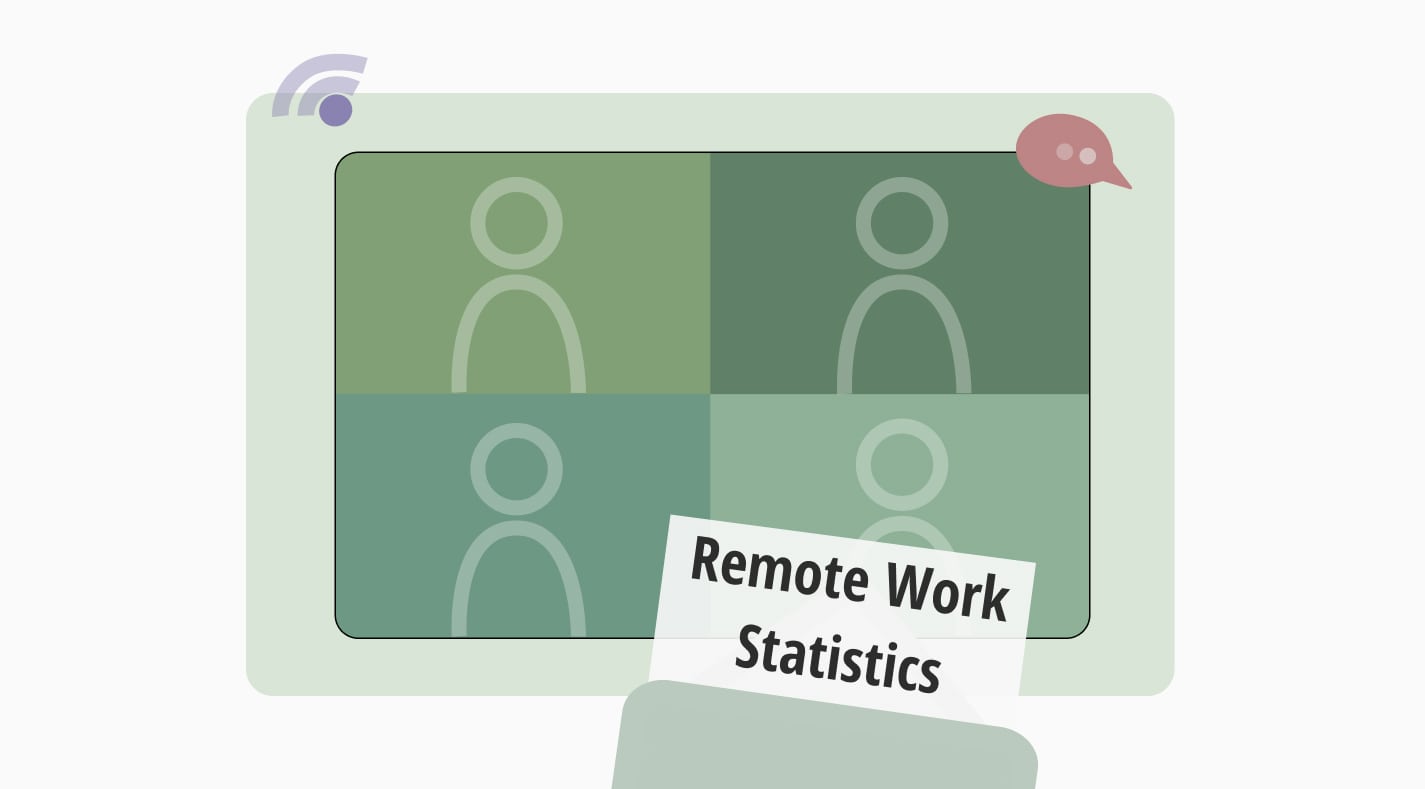Remote working has become widespread worldwide with the fast advancement of technology and the development of communication tools. Employees no longer have to be tied to a physical office environment and can work from home or other locations. Remote working offers employees flexibility in their work life and a more stress-free daily life.
The remote working model also offers undeniable advantages to employers. With remote working, companies can save money and increase employee satisfaction. We have prepared 75+ remote working statistics for you. These statistics will help you understand the benefits of remote work for employers and employees. Our statistics will also encourage you to implement the remote working model. Now, let’s move on to our statistics.
75+ Essential remote work statistics
Remote working increases your employees' motivation and work efficiency. Thanks to our working remotely statistics, you will have access to all the necessary data and information on the subject. In addition, the remote jobs statistics we have divided into different categories will enable you to cover the topic in detail and every aspect.
General statistics about remote work
You can explore general remote work statistics to get a general idea of the topic before going into specifics with categorized statistics. You can learn more about the key elements of this subject by reading general global remote work statistics. Let's look at some general data about remote work that will blow your mind:
1. According to a WFH Research survey, 67% of full-time workers work on business premises five days a week. In a hybrid arrangement, 26% of workers spend half their workweek at their employer's office and the other at home. Of full-time employees, 8% are remote employees (WFH Research).
2. 12.7% of full-time workers worked from home, compared to 28.2% who worked a hybrid work model in 2023 (Forbes Advisor).
3. According to 46% of hybrid workers, working in an office is better for advancing in their careers (Notta).
4. The number of remote work days per week in Latin America varies from 0.8 in Mexico to 1.0 in Chile (WFH Researcé).
5. In 2021, 15.8% of newly hired employees worked almost entirely from home, rarely or never set foot on company property (Federal Reserve Bank of Atlanta).
6. When working remotely, the average Canadian saves 65 minutes on their daily commute. Of the time saved, they dedicate roughly 40% to their work (C. D. Howe Institute).
7. In May 2020, 61% of work was completed by employees working from home, up from 4.7% in January 2019 (Notta).
8. An annual reduction of 54 million tons of greenhouse gas emissions into the atmosphere is possible with remote work (Global Workplace Analytics).
9. The biggest challenges for remote workers are dealing with non-work distractions (32%), not being able to build strong relationships with coworkers (25%), loneliness (23%), having trouble with technology-related issues (21%), and working across different time zones (19%), according to a Remote.co survey of 200 full-time remote workers (Remote.co).
10. 25% of workers would be ready to give up 15% of their yearly payment in exchange for flexible work hours (Owl Labs).
11. A survey shows that in the UK, employees in companies that have switched to semi-remote working are 57% less likely to leave their jobs than when they worked from a full-time office, while sickness absence is down by 65% (PBS News Hour).
12. In contrast to 55% of hybrid workers and 36% of remote workers, 59% of full-time office workers report that their stress levels have increased over the previous year (Owl Labs).
13. 52% of respondents think working remotely does not affect collaboration at all or affect it positively (Flexjobs).
14. With an average salary of approximately 95,000 dollars, workers in the technology sector who were either entirely or largely remote in 2023 earned almost 33,000 dollars more than their non-remote colleagues (Statista).
15. For work-related events, 46% of remote workers never have to travel, 32% travel once or twice a year, 13% travel three to four times a year, and 9% travel five times or more annually (Remote.co).
16. 80% of employees who work remotely would suggest it to a friend (Exploding Topics).
17. In Asia, Singapore has 0.9 remote work days per week, whereas South Korea has 0.4 (WFH Research).
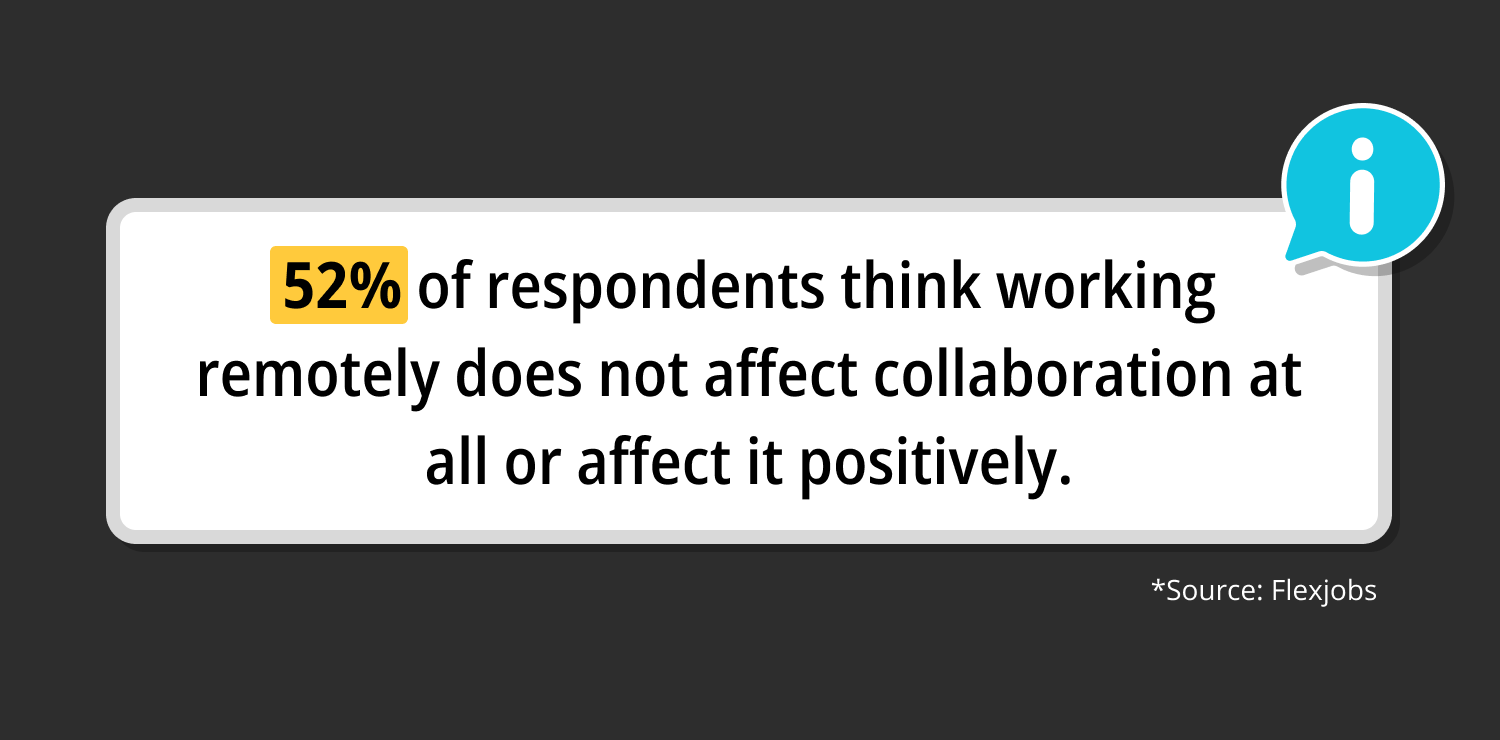
Source: Flexjobs
Remote work productivity statistics
It is widely known that remote workers are happier and more productive than those who work full-time in an office. Companies that care about employee satisfaction should definitely consider the concept of remote working. Here are some remote work productivity statistics that will guide your company:
18. Among employees who worked remotely during the COVID-19 epidemic, 26% said they would prefer to work five days a week from home. Of the respondents, 56% would like to work in a hybrid manner, and 19% would instead work entirely on-site (WFH Research).
19. According to a 2-year Stanford study, employees working in the home office feel much more productive working from home (Inc.).
20. In 2023, most participants stated that the company's executive leadership believed remote workers could be productive from home, and 54% said all workers were reliable (Statista).
21. 83% of workers worldwide believe hybrid work increases productivity (Notta).
22. In a survey conducted by WFH Research, employees ranked face-to-face collaboration (54%), socializing with coworkers (62%), and having distinct boundaries between work and personal time (43%) as the top three advantages of working on the company's premises (WFH Research).
23. Working remotely decreases employee attrition by 50% because remote workers take shorter breaks, have fewer sick days, and take less time off (Inc.).
24. 80% of employees lose time in online or hybrid meetings because of technological issues (Owl Labs).
25. 71% of the hybrid employees in the UK are less burned out, 39% less stressed, and 48% more satisfied with their job (PBS News Hour).
26. According to 87% of respondents to the Flexjobs survey, commuting affects their stress levels (Flexjobs).
27. 79% of managers believe that working remotely or in a hybrid environment increases team productivity, 11% see no change in productivity, and 10% believe productivity decreases (Owl Labs).
28. Compared to the average in-office worker, a remote team member typically works 4.15 more hours weekly in a concentrated work state (Hubstaff Blog).
29. 56% of the Flexjobs survey participants said working remotely has either helped or will definitely improve their mental health (Flexjobs).
30. In the UK, 60% of workers who switched to hybrid working said that managing work and home obligations was simpler, and 73% claimed they were happier with their lives. People slept more, had less fatigue, and had better mental health (PBS News Hour).
31. When it comes to seeking advice, 63% of remote workers stated they are more inclined to consult their colleagues who work face-to-face than their remote colleagues (Owl Labs).
32. According to 60% of WFH Research participants, the main advantage of working from home is not having to commute. According to 44% of respondents, the top benefits of remote work are the savings on gas and lunch, and 42% said the flexibility to choose when to work and better work-life balance (WFH Research).
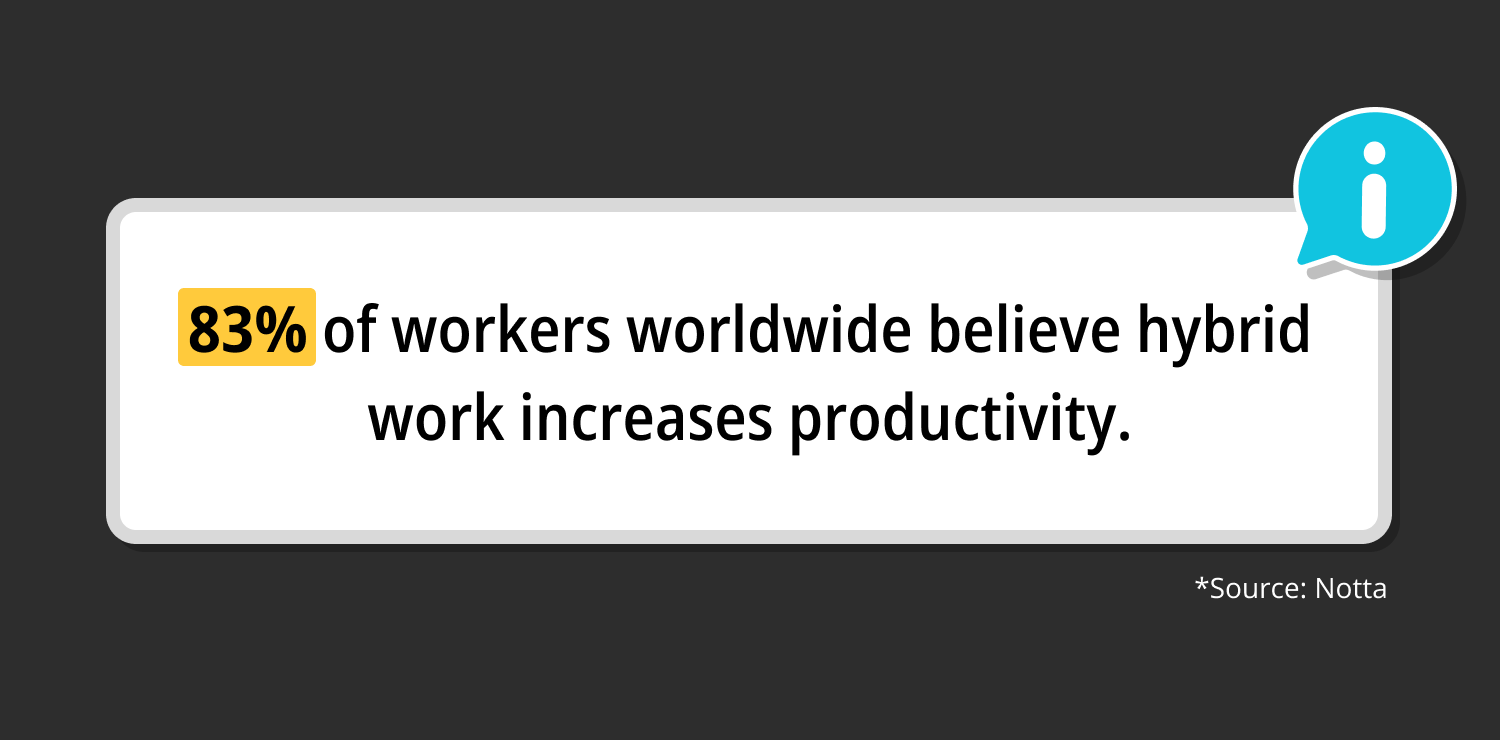
Source: Notta
Remote job and sectors
The remote working model is now widely practiced in many sectors and different types of work. Employers' recognition of the benefits of remote working for both employees and companies has led to the widespread adoption of the remote working model. Check out the remote jobs and industries statistics to find out how remote work can benefit you:
33. The top two factors influencing employees looking for a new job are location (33%) and hours (34%) flexibility in the workplace (Owl Labs).
34. According to 42% of employees hired for entirely remote roles during the pandemic, adjusting to their new roles hasn't been any simpler or more difficult than adjusting to jobs in offices before the pandemic (Federal Reserve Bank of Atlanta).
35. With 67.8% of tech employees working entirely or primarily remotely internationally in 2023, the tech sector has the largest percentage of remote workers globally (Statista).
36. Around the world, 16% of businesses allow working remotely full time, while 44% don’t offer remote work at all (Notta).
37. According to 74% of IT professionals worldwide in 2023, working remotely has improved their organization's IT department's performance in some way. Remarkably, just 2% of participants stated that working remotely had a negative impact on their IT department's performance (Statista).
38. According to 69% of respondents, traditional job expectations are the reason why their employer requires them to work in the office (Owl Labs).
39. 20% of workers have jobs that don't allow them to work from home, like positions that need them to be in a certain place (Boundless).
40. For hybrid and remote workers, 4% would quit their jobs if they could no longer work remotely or in a hybrid format, while 42% would look for another job with more flexibility (Owl Labs).
41. A WFH Research survey found that although workers only plan 1.1 remote work days per week, they would prefer to work from home an average of 2.0 days per week worldwide (WFH Research).
42. 60% of employees worry that they will miss out on opportunities and have less influence at work if they work remotely (Owl Labs).
43. According to a survey in November 2020, 25% of global companies expected that remote work would lower their real estate expenses (Statista).
44. The move to remote employment reduces the real wage catch-up effect on short-term inflation pressures by more than half, with wage growth moderated by 2 percentage points over two years (Becker Friedman Institute).
45. The agencies and consulting sector and finance and insurance sectors are among the most commonly remotely worked sectors, with 50.6% and 48.7% of employees working mainly remotely (Statista).
46. 81% of employees would be more devoted to their jobs if their companies offered remote work arrangements (TechRepublic).
47. One of the most common remote jobs worldwide is software development, which is expected to grow 24% by 2026 (Tecla).
48. In 2023, 23% of workers changed companies, and full-time office workers were more likely to do this (26%) than hybrid or remote workers (17%) (Owl Labs).
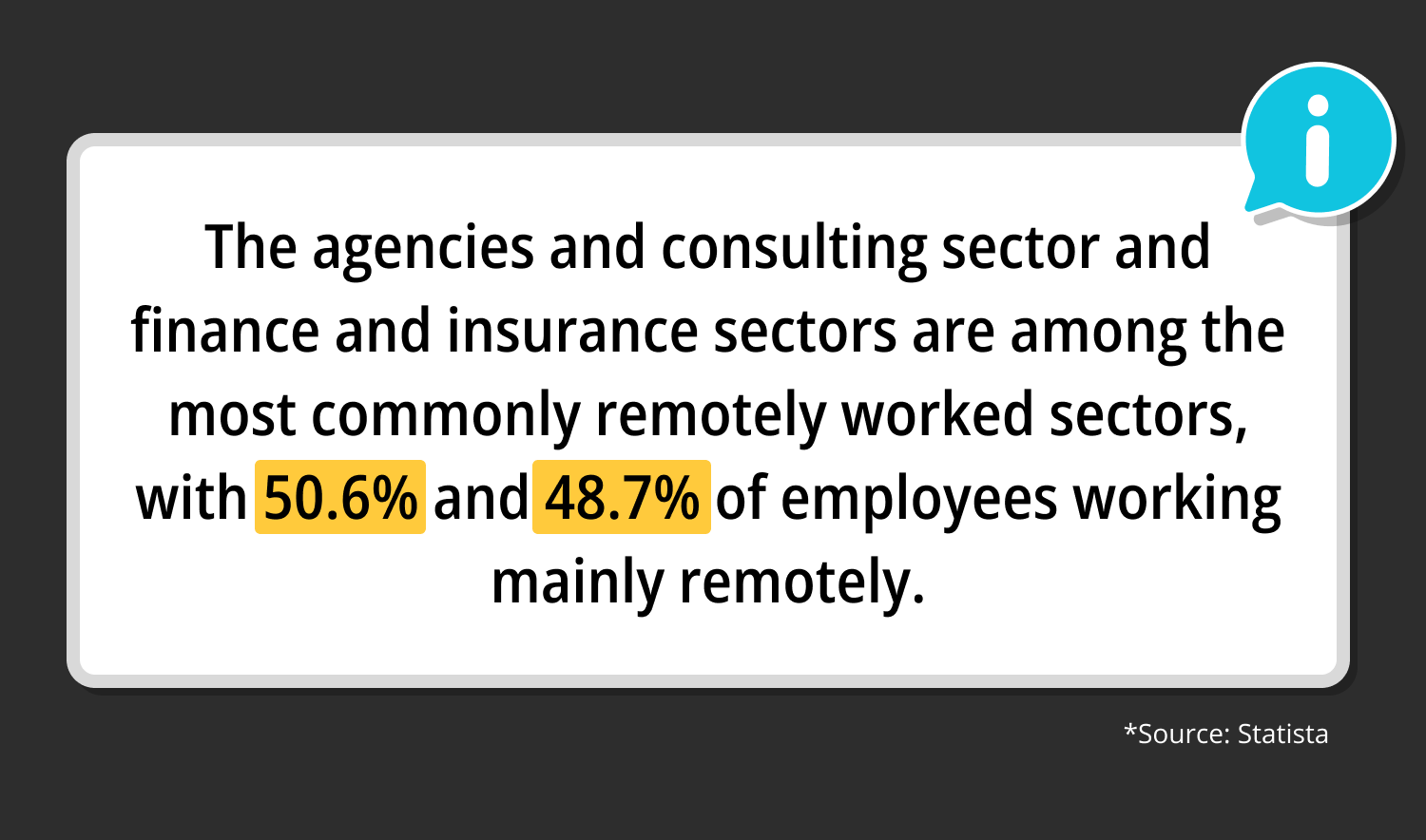
Source: Statista
Remote work growth statistics
Remote working gives companies access to a broader pool of candidates. This makes it easier to find the right employees for your business and be more successful. If you want to learn about the growth in remote work and make comparisons, check out the remote work growth statistics:
49. There is a greater prevalence of work-from-home (WFH) among English-speaking nations. Over 1.4 full paid days per week, full-time employees in the United States, UK, Canada, New Zealand, and Australia worked from home (WFH Research).
50. At a compound annual growth rate (CAGR) of 23.8%, the remote workplace services market is projected to reach 58.5 billion dollars by 2027 from 20.1 billion dollars in 2022 (Notta).
51. An estimated 62 hours of labor are lost annually by in-office teams due to everyday disruptions (Hubstaff Blog).
52. Since mid-2021, almost four out of ten businesses have stated that they are increasing the number of options for workers to work remotely or from home to maintain job satisfaction or reduce demand for wage increases (Becker Friedman Institute).
53. The percentage of workers choosing to work remotely rose by 24%, while the rate of workers selecting hybrid work has increased by 16% since 2021 (Notta).
54. Since 2015, there has been a gradual global increase in the popularity of remote work, growing at a rate of one to three percent per year. But after the COVID-19 pandemic in 2020, the proportion of remote workers rose to about 27% in 2022 (Statista).
55. Sales increased by 1.4% for businesses that implemented shorter work hours, while sales increased by more than 34% (PBS News Hour).
56. 95% of employees want remote work in some capacity, whether a hybrid or fully remote (Flexjobs).
57. Greece has the lowest work-from-home (WFH) incidence in Europe, with 0.5 days per week, whereas Finland, Germany, and the Netherlands have the highest levels, with 1.0 days per week (WFH Research).
58. According to a survey conducted in 2021, 32% of participants who work remotely, even to some extent, said that their company has a 100% remote policy. In 2020, 25% of respondents said that while remote work is allowed, it is not the norm at their organization. This percentage has decreased to 14% in 2019 (Statista).
59. On average, only 0.7 days a week are spent working from home in the seven Asian countries, 0.8 in the European countries, 0.9 in South Africa, and 0.9 in the countries of Latin America (WFH Research).
60. According to an Upwork survey, fully remote workers will make up 27.7% of the workforce, compared to partially remote workers, who will make up 20.4% (Upwork).
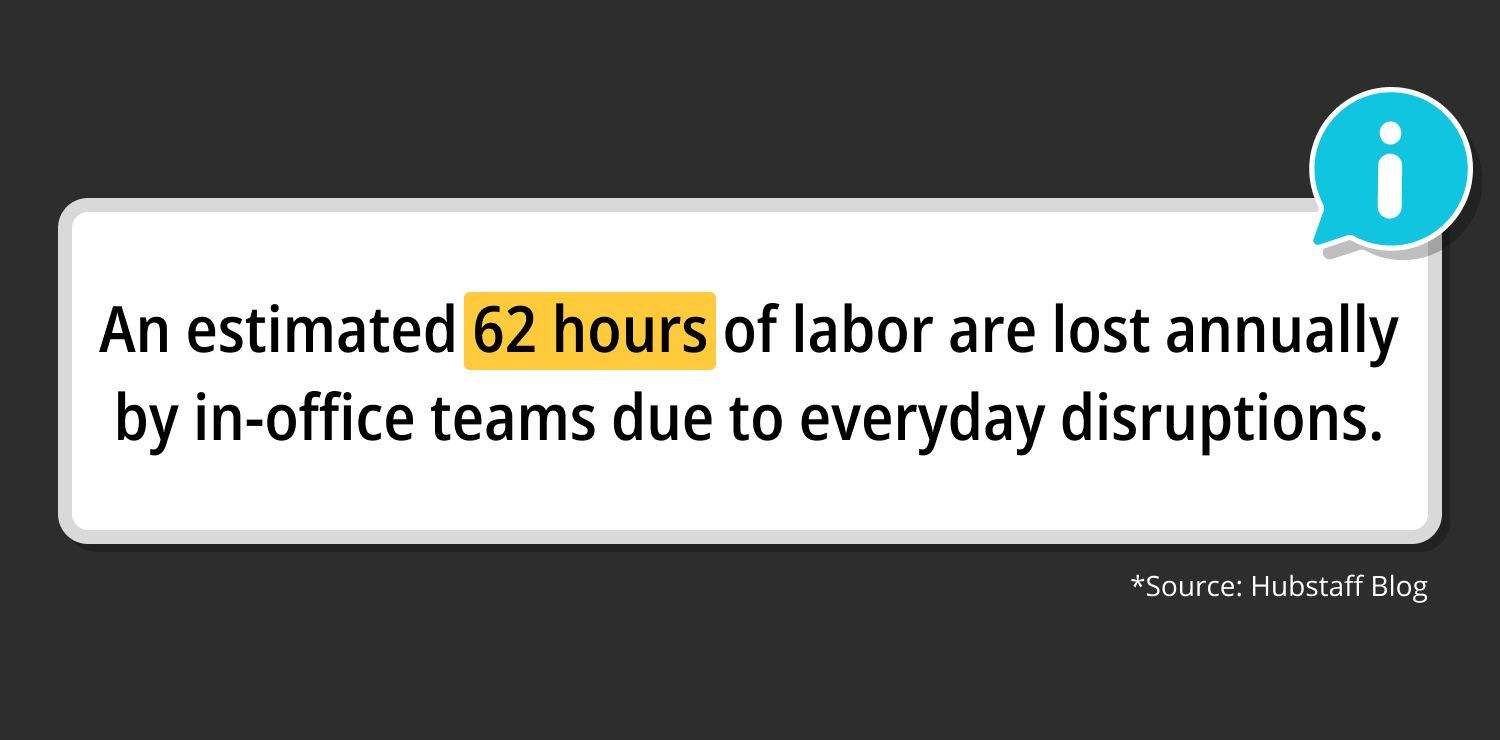
Source: Hubstaff Blog
Remote workforce statistics
Remote working eliminates the time lost commuting to and from work. Also, remote workers concentrate more on work with fewer interruptions. Reasons like these lead to an increase in the workforce. To learn more about the effects of remote work on the workforce, read the remote workforce statistics:
61. In 34 nations, full-time workers worked from home an average of 0.9 days per week between April and May 2023 (WFH Research).
62. Most managers (68%) said remote and hybrid employees cannot provide informal or impromptu feedback (Owl Labs).
63. 60% of companies that recently hired remote workers report that the integration process is more difficult (Federal Reserve Bank of Atlanta).
64. Over the same period, remote workers would have around 18% fewer interruptions (722.8) (Hubstaff Blog).
65. 53% of employers claim that the pandemic has increased their willingness to utilize freelancers (Upwork).
66. According to 53% of employees, their employer will likely change its remote or hybrid work policies during the next year (Owl Labs).
67. In South Africa and Latin America, employees want to work from home an average of 1.3 days more frequently than their employers allow (WFH Research).
68. A study showed that remote workers work a true complete shift (or more) because they don't have to be late returning to the office and leaving early, and they can concentrate more quickly because there are fewer distractions at home (Inc.).
69. Fully remote work situations are preferred by more women (58%) than men (42%) (Flexjobs).
70. Remote employees work longer hours overall, with 59.48% in an average week. This figure is over ten points higher than the average for employees who work in an office, with 48.5% (Hubstaff Blog).
71. 63% of employees are worried that managers think office workers are more reliable and hardworking than remote workers (Owl Labs).
72. In 2023, the primary reason for companies adopting remote-first or entirely remote work arrangements for employees was to increase the available talent pool. This was cited by 41% of respondents as the primary reason and 28% as the secondary reason for their decision (Statista).
73. Employers can save up to 11,000 dollars and remote workers up to 7,000 dollars annually (Tecla).
74. 29% of remote and hybrid workers said they would expect a wage rise to cover additional costs if they could not work remotely (Owl Labs).
75. In the upcoming six months, 71% of hiring managers intend to maintain or grow their usage of freelancers (Upwork).
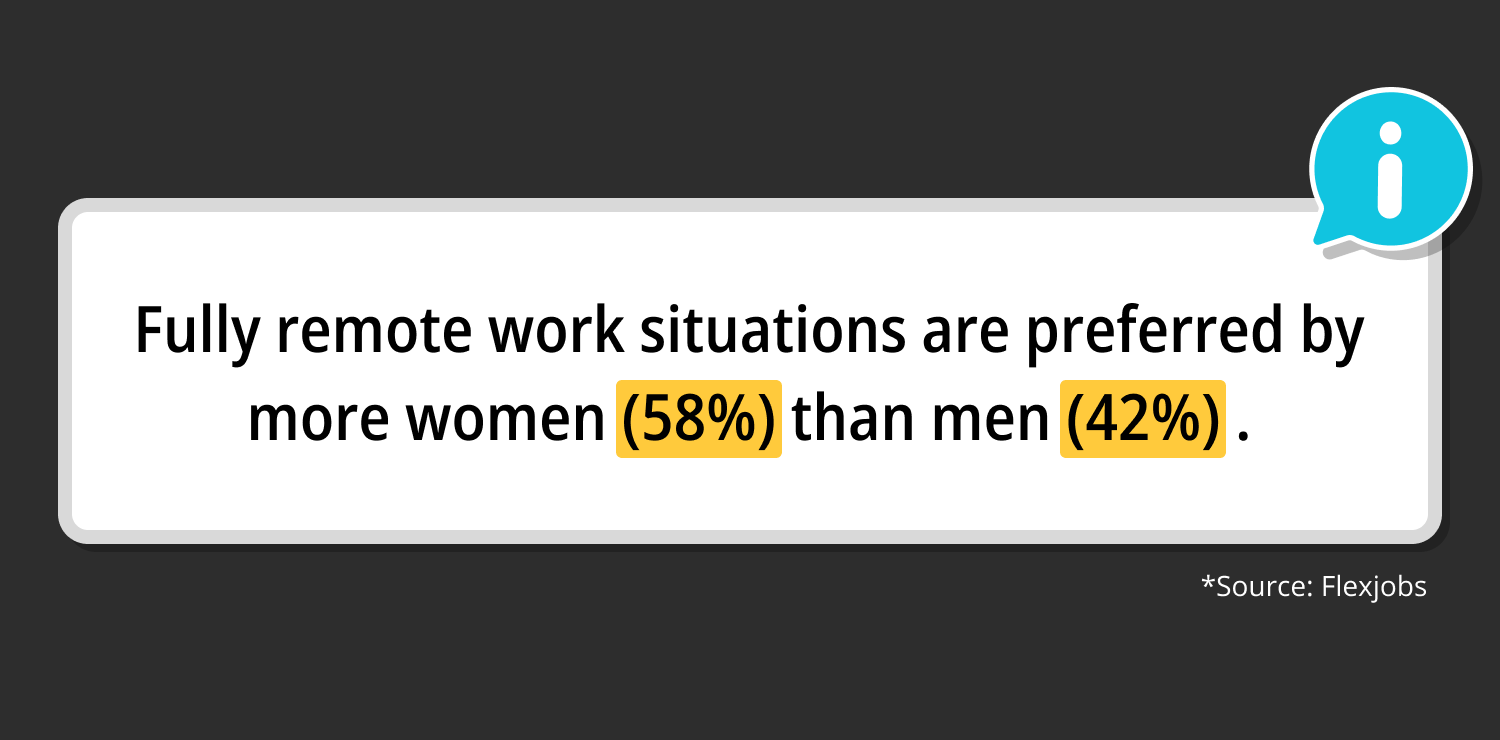
Source: Flexjobs
Final words
Remote working brings numerous benefits to both employees and employers. It positively affects the workforce in companies and increases productivity. It enables companies implementing the remote working model to get ahead of their competitors in the sector. By reading the 75+ remote work statistics we have prepared, you can clear all your questions about switching to remote working in your business.
Now, you have all the data you need to know and are ready to implement the remote working model!
Fatih is a content writer at forms.app. He is also a translator and interpreter. Fatih loves reading and writing. He is passionate about exercising and traveling. His specialties are surveys, statistics, and translation.
